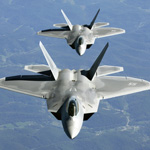F-22s could be assigned to Libyan operation

The Pentagon is generating plans for a no-fly zone over Libya—plans that could produce the first combat assignment for the F-22 Raptor stealth fighter.
Whether the idea progresses beyond this stage is subject to United Nations and NATO support, the scale of Libyan military action against its civilians, and the reluctance of the U.S. to take on stewardship of military operations in yet another Muslim country. Nonetheless, the idea does show how the U.S. Air Force confronts the task of taking down a large air defense system.
The Lockheed Martin F-22, F-16CJ Wild Weasels and some cyberoperations would be employed in shutting down Libya’s air defense system, which consists “almost exclusively” of Russian-built SA-6 surface-to-air missile (SAM)systems. The munitions are similar to those that opposed NATO forces involved in operations in Serbia and that shot down the single F-117 fighter lost in combat, says a former Air Force chief of staff. While the SA-6 Gainful (2K12 Kub) is the most effective SAM in the Libyan inventory, others include the SA-2 Guideline (S-75), SA-3 Goa (S-125) and SA-5 Gammon (S-200).
U.S. aircraft carriers are moving to the western Mediterranean, but operations in Afghanistan may not permit them to maintain a long-term no-fly zone over Libya. That task would likely fall to the Air Force, says a senior USAF official.
“Creating and enforcing a leak-proof no-fly zone over Libya can be done without stretching U.S. forces,” the veteran fighter pilot says. “The Air Force has the capacity to do this without seriously affecting its missions in Afghanistan. There is no air superiority problem in Iraq or Afghanistan that requires more fighters and AWACS [Airborne Warning and Control Systems], than [those] already committed [to that mission].”
“With respect to the no-fly zone specifically, it’s an extraordinarily complex operation to set up,” says Adm. Mike Mullen, chairman of the Joint Chiefs of Staff. “We would have to work our way through doing it in a safe manner and not put ourselves in jeopardy . . . over air defenses that could actually . . . take those aviation assets out of the air. There are an awful lot of people talking about this [no-fly zone] and an increasing desire to understand it specifically.”
Basing could be an issue. “Obviously it would be desirable to operate from bases in Italy,” the former Air Force chief of staff says. “Italy would likely allow us to use its bases because of [its] vested commitment to [maintaining] access to Libyan oil and gas.”
A worst-case scenario, with NATO rejecting support of a no-fly zone, might have shorter-range U.S. fighters flying out of Egypt, using facilities like Cairo West where multi-national Bright Star exercises are conducted. “I engaged my counterpart in Egypt a number of times,” Mullen says. “They want to sustain the relationship [with the U.S. military].”
Others with insight into the current administration in Egypt agree.
“We have a great relationship with the Egyptian air force and army and they are the ones in charge of the country,” the former Air Force chief of staff says. He notes that U.S. aircraft would not operate from bases in eastern Libya occupied by forces opposed to leader Moammar Gadhafi because of the danger of shoulder-fired missiles, anti-U.S. protests and sabotage.
“The Air Force has significant excess capacity for the Libya mission,” the veteran fighter pilot says. “It is the perfect scenario for the F-22 and F-16CJ Wild Weasels that are currently not engaged in Afghanistan. The Air Force’s bread-and-butter mission is to take down sophisticated, integrated air defense systems, attack air bases to render them unusable, destroy any radars that emit, and clear the skies of any aircraft in flight. After an intense, 24-48-hr. campaign, enforcing the no-fly zone is a routine operation.”
Larger aircraft, such as tankers, Northrop Grumman E-8 Joint Stars and Boeing E-3 AWACS could conceivably operate from Oman, Tunisia or Qatar.
The establishment of a no-fly zone would require “a massive SAM rollback effort, like that imposed on Iraq [during the Northern and Southern Watch operations after the first Iraq conflict in 1991],” the USAF official says. “Every time the Iraqis turned on a radar, we hosed them.
“Any cyberoperations would be part of the SAM rollback radar and computer-jamming program, but it would be a small part,” he says. Other targets would be communications systems. The “heavy weight of effort required” to impose a round-the-clock flight ban could require the “first actual use of the F-22.”
Defense Secretary Robert Gates confirms that discussions about the intricacies of setting up a no-fly zone were under way as part of the options and contingencies that the Pentagon is preparing for White House review. Mullen has just returned from visiting seven countries in the region to gather the opinions of his peers.
Asked about moving additional aircraft into the region, Mullen says: “We are looking at all options and a variety of contingencies. The options beyond humanitarian assistance and evacuation are complex. If we move additional assets, what are the consequences of that for Afghanistan and the Persian Gulf, [and] are our allies prepared to work with us?